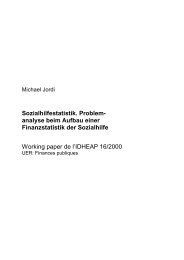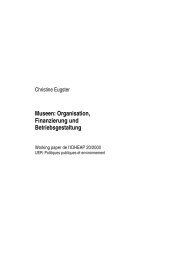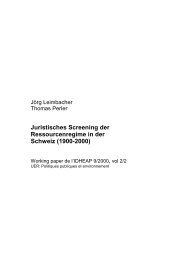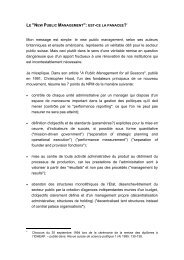Local Government and Metropolitan Regions in Switzerland - IDHEAP
Local Government and Metropolitan Regions in Switzerland - IDHEAP
Local Government and Metropolitan Regions in Switzerland - IDHEAP
You also want an ePaper? Increase the reach of your titles
YUMPU automatically turns print PDFs into web optimized ePapers that Google loves.
security <strong>and</strong> public health (hospitals), care for the elderly (<strong>in</strong>clud<strong>in</strong>g construction of homes for the elderly),<br />
provision of education, waste treatment, electricity, water, gas, <strong>and</strong> local roads. Municipalities are<br />
also <strong>in</strong> charge of local cultural affairs, the appo<strong>in</strong>tment of municipal executive <strong>and</strong> adm<strong>in</strong>istrative authorities<br />
<strong>and</strong> they decide municipality citizenship requirements. Here aga<strong>in</strong>, however, there are differences<br />
between the cantons.<br />
S<strong>in</strong>ce the implementation of policies is commonly delegated to the lower political level transfers between<br />
the different levels are quite common as a means of political steer<strong>in</strong>g <strong>and</strong> equalization. The Confederation<br />
only uses one third of its total expenditures for its own purposes whereas two thirds are transfer<br />
payments (Buschor et al. 1996: 5), most of them <strong>in</strong> favour of the cantons <strong>and</strong> some of them <strong>in</strong> favour of<br />
the municipalities. About two thirds of the transfers to the cantons have been transfers for special purposes.<br />
S<strong>in</strong>ce 2000 there has been a shift towards free transfers for the first time (Serdült/Schenkel<br />
2006: 559). Transfers from the cantons to the municipalities are less frequent. Nevertheless, one fourth<br />
of the expenditures of the cantons are transfers to the municipalities (Buschor et al. 1996:5).<br />
Jo<strong>in</strong>t <strong>in</strong>volvement across different levels leads to <strong>in</strong>terwoven policy structures which become difficult to<br />
h<strong>and</strong>le (“Politikverflechtung”, Scharpf 1978). In doma<strong>in</strong>s like roads, energy or social assistance none of<br />
the levels takes a strong lead, <strong>in</strong> doma<strong>in</strong>s like education, police, public health <strong>and</strong> social assistance,<br />
cantons <strong>and</strong> municipalities are equally <strong>in</strong>volved. It is <strong>in</strong>creas<strong>in</strong>gly compla<strong>in</strong>ed about <strong>and</strong> – as we shall<br />
see later on – has become subject to reforms that when regulation, f<strong>in</strong>anc<strong>in</strong>g <strong>and</strong> implementation of a<br />
policy do not co<strong>in</strong>cide the system becomes suboptimal.<br />
S<strong>in</strong>ce the federal level <strong>in</strong> Switzerl<strong>and</strong> is rather weak, the federal adm<strong>in</strong>istration is small, too. There are<br />
no federal civil servants becom<strong>in</strong>g active at cantonal or local level, <strong>and</strong> the same is true for cantonal civil<br />
servants <strong>and</strong> local affairs. The part of persons employed by the municipalities amounts to about 34<br />
percent of the total public work force, with 47 employed by the cantons. In the last few decades it has<br />
been the cantonal level which has <strong>in</strong>creased its share to the detriment of the national level, whereas the<br />
share of the municipal level has rema<strong>in</strong>ed relatively stable. In absolute figures the number of public<br />
employees has decreased, <strong>in</strong> terms of the total figures as well as at the national <strong>and</strong> the municipal levels,<br />
which is not only due to cuts but also to outsourc<strong>in</strong>g (for example telecommunications, <strong>in</strong>frastructure<br />
<strong>and</strong> supply services). The grow<strong>in</strong>g importance of the health <strong>and</strong> educational sectors which are <strong>in</strong> the<br />
realm of the cantons, has not only led to an <strong>in</strong>crease of the share of the cantons but also to an <strong>in</strong>crease<br />
<strong>in</strong> absolute figures.<br />
In accordance with the federalist division of power Swiss municipalities enjoy a remarkable degree of<br />
freedom with regard to their political organisation. The political organisation of a municipality is not governed<br />
by national but by cantonal legislation. There are 26 different cantonal laws tell<strong>in</strong>g the municipalities<br />
how to set up <strong>and</strong> organize their political <strong>in</strong>stitutions. This has led to a number of dist<strong>in</strong>ct political<br />
systems throughout the country (Ladner 1991). However, there are quite a few common characteristics<br />
as far as their executives, their adm<strong>in</strong>istration <strong>and</strong> their legislative bodies are concerned.<br />
Basically there are two different types of local political systems to be found. Some municipalities reflect<br />
a division of power <strong>in</strong> the sense of Montesquieu, at least as far as the executive <strong>and</strong> the legislative bodies<br />
are concerned, <strong>and</strong> have a municipal parliament represent<strong>in</strong>g the citizens, which is usually elected <strong>in</strong><br />
a PR system. Others have a municipal assembly of the citizens, which covers at least partly the legislative<br />
function, <strong>and</strong> which represents a form of direct democracy <strong>in</strong> the tradition of Rousseau <strong>and</strong> the<br />
ancient Greeks. The competences of parliament <strong>and</strong> assembly are very similar. They have both a control<br />
<strong>and</strong> an <strong>in</strong>put function <strong>and</strong> decide on all important projects <strong>and</strong> proposals which are not <strong>in</strong> the realm<br />
of the executive or the citizens at the polls. Typical concerns of parliament or assembly are municipal<br />
projects of particular importance <strong>and</strong> with f<strong>in</strong>ancial consequences above a certa<strong>in</strong> sum of money, m<strong>in</strong>or<br />
changes of municipal decrees <strong>and</strong> regulations, <strong>and</strong> the acceptance of the municipal account, the budget<br />
<strong>and</strong> the tax rate.<br />
11










